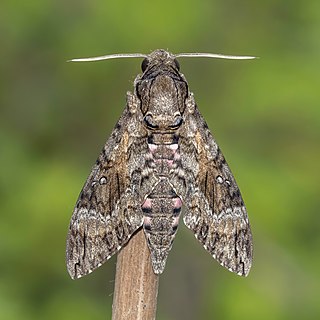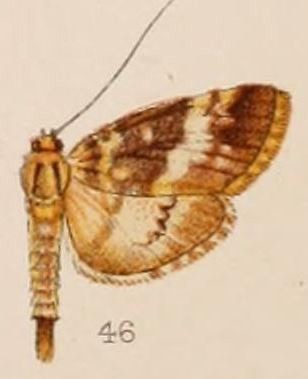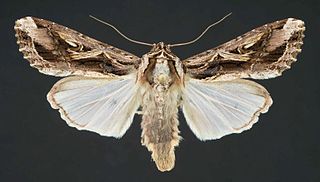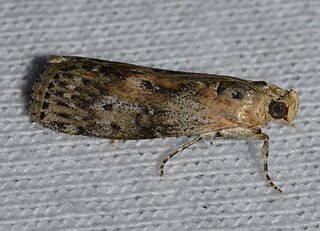
Agrius cingulata, the pink-spotted hawkmoth or sweetpotato hornworm, is a moth in the family Sphingidae. The species was first described by Johan Christian Fabricius in 1775.
Geshna is a monotypic moth genus of the family Crambidae described by Harrison Gray Dyar Jr. in 1906. It contains only one species, Geshna cannalis, the lesser canna leafroller, described by Altus Lacy Quaintance in 1898. It is found in North America, where it has been recorded from Florida, Mississippi, South Carolina, North Carolina and Tennessee. It has also been recorded from Costa Rica and Cuba.

Lygropia is a genus of snout moths in the subfamily Spilomelinae of the family Crambidae. It currently comprises 66 species, which are mostly found in the tropical and subtropical regions of the Americas, Africa and Asia, but not in Australia.

Epimecis hortaria, the tulip-tree beauty, is a moth species of the Ennominae subfamily found in North America. It is found throughout New England south to Florida and west to Texas and Missouri. It was first described by Johan Christian Fabricius in 1794. It can be seen flying from late March to early October. Adults are nocturnal and attracted to lights. The immature caterpillars can be found feeding on Magnolia, Asimina, Populus, Sassafras and Liriodendron.

Simplicia cornicalis is a litter moth of the family Erebidae. The species was first described by Johan Christian Fabricius in 1794. It is found in south-eastern Asia and the Pacific. Records include New Caledonia, Réunion, Thailand, Fiji, Hawaii, India, Sri Lanka, the Society Islands, as well as New South Wales and Queensland in Australia. It is an introduced species in southern Florida and Louisiana in the United States.

Ategumia ebulealis, the clidemia leafroller, is a moth of the family Crambidae. The species was described by Achille Guenée in 1854. It is found in Central America, the Antilles, and the south-eastern United States. It was thought to be introduced to Hawaii, but later research concluded it was actually Ategumia matutinalis which was released.

Spodoptera dolichos, the dolichos armyworm moth or sweetpotato armyworm moth, is a moth of the family Noctuidae. The species was first described by Johan Christian Fabricius in 1794. It is found from the southern United States, south through Costa Rica to South America, as far south as Argentina. In the United States, it may occur as far north as Kentucky and Maryland.

Scopula umbilicata, the swag-lined wave moth, is a species of moth in the family Geometridae. The species was first described by Johan Christian Fabricius in 1794. It is found from the southern part of the United States to South America and the West Indies.

Haplotinea insectella, the drab clothes moth or fungus grain moth, is a moth of the family Tineidae. It was described by Johan Christian Fabricius in 1794. It is found in all of Europe, except Ireland, the Iberian Peninsula and the western and southern part of the Balkan Peninsula. It is also found in North America. The species is often found in warehouses, granaries, mills and farm buildings.
Argyrotaenia quadrifasciana, the four-lined leafroller moth, four-banded leafroller or lesser all-green leafroller, is a species of moth of the family Tortricidae. It is found in North America, where it has been recorded from Nova Scotia to West Virginia, west to Arkansas and north to Alberta. The habitat consists of orchards and shrubby areas.
Achyra bifidalis is a moth in the family Crambidae. It was described by Johan Christian Fabricius in 1794. It is found from the southern United States south through Mexico to Brazil and Argentina. It is also found in the West Indies.

Diaphania costata, the orange-shouldered sherbet moth or erroneously the white palpita moth, is a moth of the family Crambidae. The species was first described by Johan Christian Fabricius in 1794. It is widely dispersed, being found in the Indomalayan realm, as well as Europe. It is also found in Mexico and Texas, possibly having been introduced accidentally.
Ercta vittata is a moth in the family Crambidae. It was described by Johan Christian Fabricius in 1794. It is found in the West Indies and South America. It has also been recorded from Costa Rica and southern Florida.

Sciota virgatella, the black-spotted leafroller moth, is a species of snout moth in the genus Sciota. It was described by James Brackenridge Clemens in 1860. It is found in North America, where it has been recorded from Arkansas, Florida, Georgia, Illinois, Indiana, Maine, Maryland, Massachusetts, Minnesota, New Jersey, New York, North Carolina, Ohio, Oklahoma, Ontario, Pennsylvania, Quebec, South Carolina, Tennessee, Texas, Virginia and West Virginia.

Lineodes integra, the eggplant leafroller moth or nightshade leaftier, is a moth of the family Crambidae. It is found from the southern United States, south to Chile. It has also been recorded from Illinois, Michigan, Ontario and Cuba.

Lygropia rivulalis, the bog lygropia moth, is a moth of the family Crambidae. It is found in North America, where it has been recorded from Arizona, California, Illinois, Indiana, Iowa, Kentucky, Maine, Maryland, Massachusetts, Michigan, Minnesota, New Hampshire, New Jersey, New York, North Carolina, North Dakota, Ohio, Oklahoma, Ontario, Pennsylvania, Quebec, South Carolina, Tennessee, West Virginia and Wisconsin. The habitat consists of boggy or wet areas.

Lygropia plumbicostalis is a species of moth in the family Crambidae. It was described by Augustus Radcliffe Grote in 1871. It is found in the United States, where it has been recorded from Arizona, Florida and Texas.

Polygrammodes eleuata, the red-spotted sweetpotato moth or many-spotted moth, is a moth in the family Crambidae. It was described by Johan Christian Fabricius in 1777. It is found in Central and South America, on the Antilles and in the southern United States, where it has been recorded from Florida.

Olethreutes permundana, the raspberry leafroller, is a species of tortricid moth in the family Tortricidae. It is found in the eastern United States, south-eastern Canada and north-western North America. The species was described by James Brackenridge Clemens in 1860.














